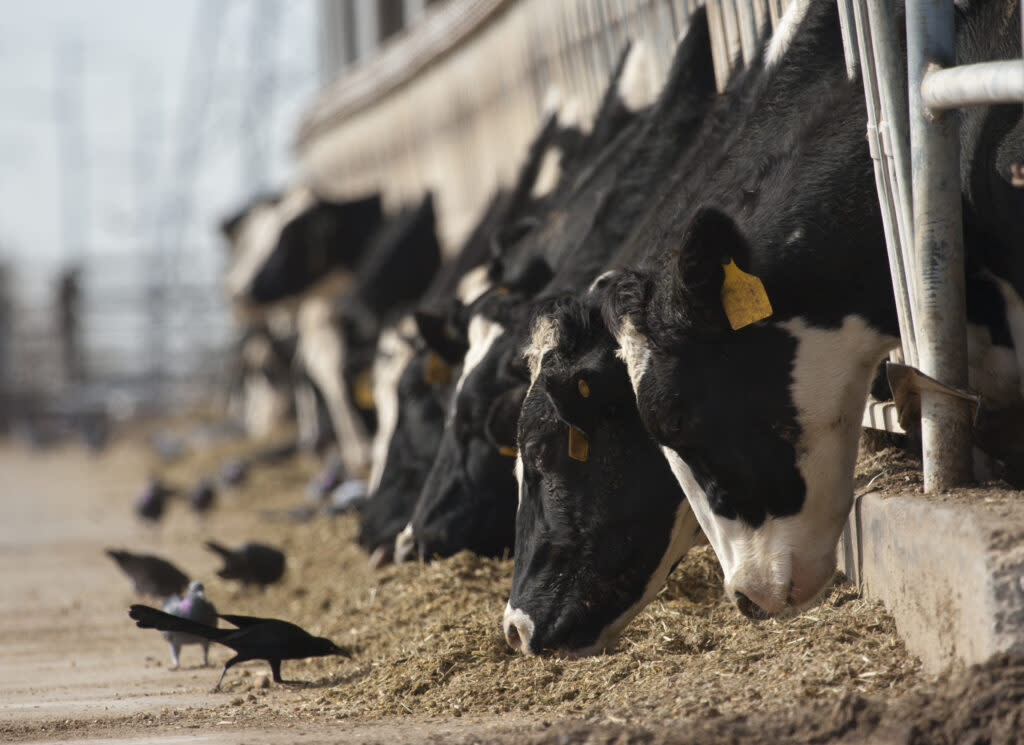No new NM dairy cow avian flu cases confirmed in weeks

Dairy cows eat alongside blackbirds. No new cases of avian flu in New Mexico dairies have been confirmed since April 17. (Stock photo via Getty Images)
Despite surrounding states recording additional herds infected with avian flu in recent weeks, there’s been no change in the number reported in New Mexico.
New Mexico is still counting eight herds with confirmed positives of Highly Pathogenic Avian Influenza, all in Curry County, and no presumptive positive cases, state agriculture officials said Monday.
“We do not have exact numbers of cows affected in each herd, but the average has been about 10%,” state veterinarian Samantha Uhrig said in a written response to questions.
The state is unaware of any cow deaths that are directly attributed to avian flu, she added.
Uhrig said the state will not name infected dairies and will only identify them at the county level.
The most recent data from 2022 estimated that Curry County has 21 dairy farms, and about 78,300 milk cows, according to the U.S. Department of Agriculture census.
Last month’s outbreak of influenza strain H5N1 affected more than 33 dairy cow herds across eight states: Idaho, South Dakota, Michigan, Ohio, South Carolina, Kansas, Texas, Colorado and New Mexico. A Centers for Disease Control and Prevention report on infections in cats at a Texas Panhandle dairy found that of 24 cats that drank raw milk from infected cows, 12 died.
New Mexico had an outbreak of avian influenza in a neighboring Roosevelt County poultry facility, which required all of the birds to be euthanized. The birds were infected by the same strain that’s infecting cattle, the USDA confirmed in late April, documenting cases in eight facilities in five states (New Mexico, Kansas, Texas, Michigan and Minnesota).
One Texas dairy worker tested positive for H5N1, the second case reported in the U.S. No other human cases have been reported since April 1. Three workers in New Mexico were tested, but all of those tests came back negative, state health officials told Source NM Friday.
The USDA also found an asymptomatic cow from an affected herd sent for slaughter had H5N1 in its lung tissue. But according to the USDA, the cow did not enter the food supply.
So far, federal officials are only mandating testing for dairy cows moving between states.
An April 29 order from USDA said any dairy cows moving between states must receive a negative test for Influenza A virus from a certified lab.
This requirement does not apply to cows moving within a state, according to a clarification from the department. To send a cow to slaughter or sale barn in state, only a Certificate of Veterinary Inspection “stating the animal is healthy” is required — not testing.
The USDA will reimburse costs for samples sent to National Animal Health Laboratory Network labs for dairy cattle suspected of having the disease, those that are asymptomatic, cattle that’s about to be moved and other animals present on dairies that have an outbreak, according to the order.
Milk, eggs, beef
Food and Drug Administration tests found remnants of the H5N1 virus in 20% of commercial pasteurized milk product samples. The FDA emphasized the material was inactive during the process and does not pose risks to consumers, and that all 297 retail dairy samples were negative for a viable virus.
“To date, we have seen nothing that would change our assessment that the commercial milk supply is safe,” the FDA said in an April 24 statement.
In additional tests on eggs on May 10, all samples were negative for a viable virus. Separately, the USDA tested 30 samples of beef from affected states, and all were negative for the virus.
The FDA said it would continue with sampling and surveillance of food supplies.
Federal officials urge people not to drink unpasteurized or “raw milk.”
GET THE MORNING HEADLINES DELIVERED TO YOUR INBOX
The post No new NM dairy cow avian flu cases confirmed in weeks appeared first on Source New Mexico.

